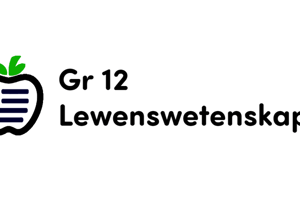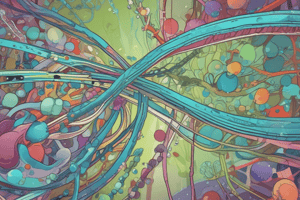Podcast
Questions and Answers
Individuals expressing a recessive trait are typically ___.
Individuals expressing a recessive trait are typically ___.
- Homozygous dominant
- Homozygous recessive (correct)
- Heterozygous
- Carriers
If a trait shows up in every generation, it is likely to be ___.
If a trait shows up in every generation, it is likely to be ___.
- Sex-linked
- Dominant (correct)
- Autosomal
- Recessive
In a pedigree, males are more frequently affected by a sex-linked trait because they have___.
In a pedigree, males are more frequently affected by a sex-linked trait because they have___.
- One Y chromosome
- Two X chromosomes
- Only one X chromosome (correct)
- No Y chromosome
What is the genotype of individuals with dimples according to the text?
What is the genotype of individuals with dimples according to the text?
When interpreting a pedigree, it's crucial to consider all possible ___ to narrow down possibilities.
When interpreting a pedigree, it's crucial to consider all possible ___ to narrow down possibilities.
What do squares represent in pedigree diagrams?
What do squares represent in pedigree diagrams?
How are mating pairs represented in a pedigree diagram?
How are mating pairs represented in a pedigree diagram?
What do shaded symbols typically represent in pedigree diagrams?
What do shaded symbols typically represent in pedigree diagrams?
How can one differentiate between affected males and females in sex-linked traits on a pedigree diagram?
How can one differentiate between affected males and females in sex-linked traits on a pedigree diagram?
What can be deduced about a trait if it is expressed even if only one copy of the allele is present?
What can be deduced about a trait if it is expressed even if only one copy of the allele is present?
What is the likely genotype of individuals expressing a recessive trait?
What is the likely genotype of individuals expressing a recessive trait?
Why are males more frequently affected by sex-linked traits in pedigrees?
Why are males more frequently affected by sex-linked traits in pedigrees?
In a pedigree, how can carriers of a recessive trait be identified?
In a pedigree, how can carriers of a recessive trait be identified?
When interpreting a pedigree, what is essential to consider to narrow down genotype possibilities?
When interpreting a pedigree, what is essential to consider to narrow down genotype possibilities?
What is the likely genotype of individuals not expressing a dominant trait?
What is the likely genotype of individuals not expressing a dominant trait?
Why do parents who do not express a recessive trait but have an affected child both must be carriers?
Why do parents who do not express a recessive trait but have an affected child both must be carriers?
In a color-blindness pedigree, why are males more frequently affected by the trait?
In a color-blindness pedigree, why are males more frequently affected by the trait?
What do shaded symbols typically represent in pedigree diagrams?
What do shaded symbols typically represent in pedigree diagrams?
In pedigree diagrams, what do squares represent?
In pedigree diagrams, what do squares represent?
How are mating pairs represented in a pedigree diagram?
How are mating pairs represented in a pedigree diagram?
What is the significance of using squares and circles in pedigree diagrams?
What is the significance of using squares and circles in pedigree diagrams?
If a trait is expressed only when two copies of the allele are present, it is likely to be ___?
If a trait is expressed only when two copies of the allele are present, it is likely to be ___?
What does a vertical line leading downwards to other symbols represent in pedigree diagrams?
What does a vertical line leading downwards to other symbols represent in pedigree diagrams?
In sex-linked traits on pedigree diagrams, how are affected males represented?
In sex-linked traits on pedigree diagrams, how are affected males represented?
What can be deduced about a trait if it is expressed even if only one copy of the allele is present?
What can be deduced about a trait if it is expressed even if only one copy of the allele is present?
Which individuals do unshaded symbols represent in pedigree diagrams?
Which individuals do unshaded symbols represent in pedigree diagrams?
How can one differentiate between affected males and females in sex-linked traits on pedigree diagrams?
How can one differentiate between affected males and females in sex-linked traits on pedigree diagrams?
What can be inferred about a trait if it is only expressed in individuals with two copies of the allele present?
What can be inferred about a trait if it is only expressed in individuals with two copies of the allele present?
Why do pedigree diagrams use shading to represent individuals with a particular trait?
Why do pedigree diagrams use shading to represent individuals with a particular trait?
If a pedigree diagram shows a trait appearing in every generation, what type of inheritance pattern is most likely at play?
If a pedigree diagram shows a trait appearing in every generation, what type of inheritance pattern is most likely at play?
In a pedigree diagram, how are affected females with a sex-linked trait typically represented?
In a pedigree diagram, how are affected females with a sex-linked trait typically represented?
What does the presence of vertical lines leading downwards to other symbols indicate in a pedigree diagram?
What does the presence of vertical lines leading downwards to other symbols indicate in a pedigree diagram?
If a recessive trait is observed in an individual, what can be concluded about the parents?
If a recessive trait is observed in an individual, what can be concluded about the parents?
What is the significance of using squares to represent males and circles to represent females in pedigree diagrams?
What is the significance of using squares to represent males and circles to represent females in pedigree diagrams?
How can one differentiate between affected and unaffected individuals in pedigree diagrams?
How can one differentiate between affected and unaffected individuals in pedigree diagrams?
What does it suggest if a trait is observed in multiple generations but skips some generations in a pedigree diagram?
What does it suggest if a trait is observed in multiple generations but skips some generations in a pedigree diagram?
How can one determine if a specific trait on a pedigree diagram is sex-linked?
How can one determine if a specific trait on a pedigree diagram is sex-linked?
If a trait shows up in every generation, what is the most likely genotype of the individuals expressing the trait?
If a trait shows up in every generation, what is the most likely genotype of the individuals expressing the trait?
In a pedigree, how can homozygous recessive individuals for a dominant trait be identified?
In a pedigree, how can homozygous recessive individuals for a dominant trait be identified?
When analyzing a pedigree, what is a likely genotype of individuals who do not express a recessive trait?
When analyzing a pedigree, what is a likely genotype of individuals who do not express a recessive trait?
In a pedigree diagram, what do unshaded symbols typically represent?
In a pedigree diagram, what do unshaded symbols typically represent?
For a dominant trait, which genotype would individuals not expressing the trait most likely have?
For a dominant trait, which genotype would individuals not expressing the trait most likely have?
In a pedigree, how can carriers of a recessive trait be identified?
In a pedigree, how can carriers of a recessive trait be identified?
What is the possible genotype of individuals with dimples according to the text?
What is the possible genotype of individuals with dimples according to the text?
Why are males more frequently affected by sex-linked traits in pedigrees?
Why are males more frequently affected by sex-linked traits in pedigrees?
In a pedigree diagram, what do squares typically represent?
In a pedigree diagram, what do squares typically represent?
Why is it crucial to consider whether a trait is autosomal or sex-linked when interpreting a pedigree?
Why is it crucial to consider whether a trait is autosomal or sex-linked when interpreting a pedigree?




